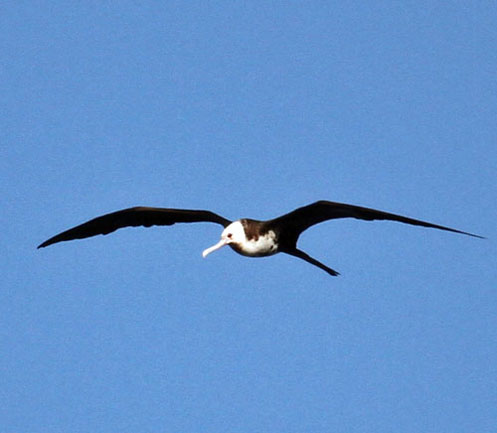| |
#1
American Woodcock on 9 Nov 1998 at Iron Mt. Pump Station, SBE
[distance of chase: 1174 miles from Pacific Grove, roundtrip]
This
was the most satisfying chase of all time for me. The Woodcock was a
first record for California. It was far away in a very remote site in
the Mojave Desert at the other end of the State. It had been discovered
on 3 Nov 1998 but only refound once in the next five days. Still, on
what would be its 6th day, I started out on the nearly 1200 mile drive
on the chase.
After 7 hours on the
road, I arrived at 1:30 p.m. in howling winds, and ran into Bruce
Broadbooks, Tom Wurster, and Mike San Miguel. We found only 12 species
in the next 3.5 hours. For some unknown reason, I didn't give up. I
drove to Needles (80 mi farther) to overnight, and returned by 6:30
a.m. on 9 Nov for one more shot before heading home. I almost
immediately found the woodcock in a front yard of small house, and
cautiously took photos. I then backed away and left the woodcock
undisturbed at the same spot. As it turned out, I was the only person
to photograph this first record (Patten et al. 1999).
An extra reason for personal satisfaction was that long ago I was given "American Woodcock" as my totem bird-name, for reasons known only to the naming committee. My book Rare Birds of West Coast
(1980) was self-published with my father under the name "Woodcock
Publications." There was thus a certain symmetry in being among the
very few to see this vagrant on the West Coast.
both photos 9 Nov 1988 © D. Roberson
|
|
|
#2
Blue-footed Booby on 6 Nov 1971 at Salton City, IMP
[distance of chase: 1030 mi from Angwin (Pacific Union College), roundtrip]
This Blue-footed Booby
at the Salton Sea was my first real chase. I choose it as my
second-most-memorable chase because it was a success, and therefore
directly led to more chases, more successes, and a totally new
lifestyle.
In 1971, I was a freshman in
college with little red VW bug. Two seniors at my college were birders
(Wally Sumner, Ken Knittle) and somehow one of us heard about the booby
invasion at the Salton Sea that fall. In Aug-Sep there were at least 75
Blue-foots around southern California and up to 48 at Salton City. By
November the invasion was over, but we didn't know that. The three of
us, plus my girlfriend, packed into the VW for the 1000 mile chase. We
found two live Blue-foot at Salton City and two dead ones on the beach.
These were the last to be seen in fall 1971; my initials on the 6 Nov
report (in Am. Birds 26: 119) was my first official report of a rare bird.
At the time I was a biology major and working
to learn taxidermy at the college's little museum. So we put the two
dead boobies in the trunk for the long drive back. They stunk up the VW
pretty well, and then working to eviscerate and stuff them over the
next weeks made me smell strongly of dead booby as well. Even the
girlfriend avoided me for a time.
photo 6 Nov 1971 © D. Roberson
|
# 3
Ross's Gull on 12 Jan 2017 at Grenada SM
[distance of chase: 103 miles from Pacific Grove, roundtrip]
Do
you believe in Redemption? I do. Hallelujah. By far the most depressing
chase of my life was a nearly 1200 mile effort for the State's first
Ross's Gull, found by Guy McCaskie at Red Hill Marina, IMP, on Friday,
17 Nov 2006. I should have left when we heard about it Friday night but
decided to wait a day to see it was 'chaseable.' It was. So Saturday
evening I took off alone, driving until exhausted at 1 a.m. out in
Mojave, stopped at Motel 6 for a couple hours of sleep, and was up
pre-dawn to continue. I arrived at Red Hill at 8:45 a.m. — and learned
that the gull flown away at 6:15 a.m. A hundred birders were there
looking for it all day, but it was gone. The discouraging event became
my punch line in response to Luke Cole's chasing poem [see next page].
Eleven years go by. It is a Thursday afternoon when email hit that a Ross's Gull
was near Half Moon Bay! This time Rita and I dropped everything and
were there in less than two hours after a very fast drive! Dozens of
birders were present on arrival, watching the gull sitting on the sea.
It then took off, flew across Hwy 1, and landed in the 'surfer's
parking lot' behind us. It was nervous, landing at various spots
(including a street where it was almost crushed by a fast truck); and
eventually flew towards the sea. It was just so gorgeous.
We later learned that at midday Saturday the
Ross's was hunted and caught by a cooperating pair of Peregrine Falcons
(Sole 2017).
photo 12 Jan 2017 © D. Roberson
|
|
|
# 4
Little Curlew on 17 Sep 1984 at Santa Maria bottoms SBA [top left]
[distance of chase: 370 miles from Pacific Grove, roundtrip]
and
Little Curlew on 9 Sep 1994 at Carmel River State Beach MTY [bottom left]
[distance of chase: 18 miles from Pacific Grove, roundtrip]
Paul
Lehman found this first North American record on the evening of 16 Sep
1984; he had been chasing a Curlew Sandpiper (and saw that as well). I
was among 40 or more who were looking for the curlew the next morning
across the Santa Maria bottoms. Chris Spooner, Steve Wilson, and I
refound it, about a mile from its original location, at 1 p.m. [my
flight shot of it is at upper left]. This proved to the the Mahoney
property that it frequented for many days thereafter; see Schram (1985)
for an account of the "event" and Lehman & Dunn (1985) for more on
the record — a first for the Western Hemisphere.
The 1984 vagrant was in juvenal plumage. Four years later a Little Curlew
turned up just a couple miles from the initial spot, and five years
after that an adult was seen on an adjacent beach close by. Finally, in
Sep 1994, an adult was at Carmel River State Beach [my photo of that
bird is below left]. Given this species small world population and its
extreme rarity in North America, I believe the same bird was involved
in all of California's records.
Little
Curlew has a long migration route from Siberia to Australasia, and
birds with long routes can make migrational errors. Still, I think this
is one of the rarest birds ever in California, and rank seeing it very
high on my chase list.
photo 17 Sep 1984 (upper left) & 9 Sep 1994 (lower left) © D. Roberson
|
# 5
Common Cuckoo on 28 Sep 2012 at Watsonville SCZ
[distance of chase: 68 miles from Pacific Grove, roundtrip]
Two Old World Cuculus cuckoos are extremely rare vagrants to Alaska. Both Common Cuckoo
and Oriental Cuckoo are long-distance migrants and "could" reach
California if one went the "wrong-way," but I had never anticipated one
would be chaseable. They are just too rare, too shy, too elusive, and
damn hard to separate if not seen well. Yet on 28 Sep 2012 we got word
that our good friend Lois Goldfrank and a Santa Cruz Bird Club field
trip had found one in Watsonville, just north of the Monterey Co.
border!
I have never been so nervous on a
chase than the 34 miles to Watsonville. Thankfully, the willow habitat
was not too extensive and I saw the bird in flight almost immediately.
I was able to creep into the willow patch and find this young
hepatic-morph female perched, and was able to lead a group of quiet
birders in to view it. Later it moved to the edge of the willow thicket
for all to see — and it provided nice views of rump, tail pattern, and
other features that together ruled out other Cuculus cuckoos. I certainly consider it among the most amazing Old World passerine to ever reach California.
photo 28 Sep 2012 © D. Roberson
|
|
|
# 6
Swallow-tailed Gull on 7-8 June 1985 at Pacific Grove MTY
[distance of chase: 2.1 miles from Monterey, one way]
Little
did I know when I answered my office phone on the morning of 7 June
1985 that it would change my life. On the line was my friend Alan
Baldridge, librarian at Stanford's Hopkins Marine Station, straddling
the border between Monterey and Pacific Grove. "I've just seen a Swallow-tailed Gull,"
said Alan. "That's obviously an escapee," said I, "but I'll come look
at it." And so I did. It was a gorgeous adult. I helped arrange access
for birders over its short stay, shepherding folks to and from the
Hopkins' site, and on its final day got the word to all that the gull
was at the Moss Landing gull roost.
There
is no space here to relate the years of debate over the origin of this
night-feeding Galapagos-breeding gull. Alan, with his knowledge of
multiple scientific disciplines, understood the impacts of the greatest
El Niño of this century, and Swallow-tailed Gull proved unknown
in captivity. The arguments for 'ship-assistance' were, er, extremely
creative. Some friendships dissipated. It took 15 years before this
vagrant was fully accepted by CBRC, ABA, and AOU. In the interim it
became my moniker Creagrus [the genus of this bird]. Folks now know it as among the most spectacular birds to reach California.
photo 7 June 1985 © Peter LaTourrette
|
# 7
Terek Sandpiper on 5 Sep 1988 at Carmel River State Beach MTY
[distance of chase: 8480 miles from Bali, Indonesia, 8357 by air]
This
first California record was found on 28 Aug 1988 by visiting birders
from Maryland. I heard about it several days later in Denpasar,
Indonesia, where I was near the end of a tour of Java and Bali with Ben
King, when I heard about it. I was able to arrange a flight home a day
earlier than scheduled in hopes of chasing it. I arrived mid-day to a
beach full of dogs and children, but then the Terek appeared. As it
turned out the haste was unnecessary as the Terek stayed until 23 Sep,
and I saw it several more times. [I did arrive home in time to see a
Hudsonian Godwit found the day before, but dipped on a Long-toed Stint
present near Salinas from 29 Aug-2 Sep 1988.] This Terek Sandpiper remains (at least to 2017) the only State record [as does the missed Long-toed Stint.]
Little Curlew [#4, above] may be the rarest Old
World wader to reach North America but Terek Sandpiper must be the most
endearing wader for its short legs, its long upturned bill, and its
status as a major rarity in the New World. It occurred in a year (1988)
that had an amazing run of Siberian vagrants (including Gray Wagtail,
see #8), and bested the prior set of Palearctic rarities that appeared
during the "Siberian express" winter of 1983-94.
photo 6 Sep 1988 © D. Roberson
|
|
|
# 8
Gray Wagtail on 10 Oct 1988 at Salinas River mouth MTY
[distance of chase: 36 miles from Pacific Grove, roundtrip]
This
first State record was found on Sunday afternoon of 9 Oct 1988 by David
Sibley & Jeff Kingery, who missed attending a party being thrown by
the late, great Margaret Moody for esteemed biologists, and to which I
had been invited. They told us later the bird had been flushed by
hunters, so we all assumed it was long gone. In any event, many of us
left at 10 p.m. that night on a long-scheduled 24-hour boat trip from
Monterey to the Davidson Seamount. But the weather as rough off Pt.
Pinos and the trip was canceled; we returned to Monterey harbor by
dawn. This was fortunate because it allowed many of us to chase — and
see — this Gray Wagtail. It remains to this date (2017) the only California record of this Siberian vagrant.
The wagtail foraged along the shore and rip-rap
at the river mouth estuary, sometimes flying close enough for photos
(my flight shot is shown at left against the backdrop of birders
viewing it through scopes). It took a lot of luck to tick this major
rarity, including the luck of living nearby and the luck of bad weather
offshore!
photo 10 Oct 1988 © D. Roberson
|
# 9
Yellow-browed Warbler on 25 Oct 2019 at Markleeville ALP
[distance of chase: 542 miles from Pacific Grove, roundtrip]
Any Old World warbler is a major rarity in California. Two Phylloscopus warblers — Arctic P. borealis and Dusky P. fuscatus
— have reached the State over the past 50 years, and I'd been able to
see both species. A diversity of Old Warblers in Alaska might be
anticipated, but I'll admit that the chance of seeing a Yellow-browed
Warbler P. inornatus in California was not on my radar. But
such word came on Thursday night, 24 Oct, that Todd Easterla had found
one in Alpine County. Alpine County! Who could have ever guessed.
It is 5.3 hours of hard driving to get from
Pacific Grove to Markleeville, the small town east of the Sierran
divide where the warbler had been found. When we heard the
Yellow-browed was still present on Friday morning, Rita & I were
off on the chase. The weather was good, the roads not too crowded, and
luck was with us. When we arrived in the last hour of the afternoon sun
at 3:40 p.m., birders were still watching this almost kinglet-sized
sprite. It was actively feeding in the foliage of a stunted apple tree,
and successfully catching small worms and spiders.
We had booked a room at Woodfords, a few miles
away, and looked again the next morning. It was then Saturday and ~100
birders from across the continent were present at the small county
park. Alas, the warbler was gone with the night's cold front. We were
essentially the last observers to see it.
photo 25 Oct 2019 © D. Roberson
|
|
|
# 10
Northern Gannet on 12 Sep 2012 on SE Farallon I., SF
[distance of chase: 270 miles from Pacific Grove, roundtrip, 36 of it by boat]
On 25 Apr 2012, researchers on SE Farallon I. spotted a Northern Gannet in flight, and obtained photos. Northern Gannet
is a common seabird of the North Atlantic but until now it had never
been reported in the Pacific Ocean. Global warming has resulted in a
reduction in pack ice and and an increase in open water all the way
across the top of the continent. This gannet probably followed that
water and ended up in the wrong ocean.
My
first two attempts to see it were aboard whale-watching boats from San
Francisco. Our visits were limited to about an hour at midday. Farallon
biologists later learned that the Gannet appeared more often in the
late afternoon after foraging offshore all morning. Alvaro Jaramillo
chartered a boat from Half Moon Bay for a chase on 12 Sep 2012. We
arrived about 11:30 a.m. but it took a long and stressful four hours of
circumnavigating and waiting until the Gannet appeared at 3:31 p.m.! We
had distant flight views until it landed at its evening roost.
Vignettes of those views appear against the backdrop of SE Farallon I.
(left).
This was my 600th bird for California, a
milestone reached first by Guy McCaskie. I have a page of reflections
on reaching this number. Now, five years later (2017) the Gannet is
still around and has been seen from Marin Co. to Año Nuevo, S.M.
Rita and I scoped it from the San Francisco waterfront as it roosted on
Alcatraz I. on 22 June 2014.
all photos 12 Sep 2012 © D. Roberson
|
... AND THE NEXT TEN ....
|
#11
Baird's Sparrow on 6 Oct 1981 at Pt. Loma, SD
[distance of chase: 980 miles from Pacific Grove, roundtrip; 830 by air]
A first-fall Baird's Sparrow
found 5 Oct 1981 by Doug Willick was seen by multitudes over next five
days. I flew down from Bay Area, was picked up by Elizabeth Copper at
the San Diego airport, and saw bird in the Pt. Loma cemetery with
Richard Webster, Herb & Olga Clarke, Larry Sansone and many others.
In contrast to its behavior on its breeding grounds, this grassland
sparrow was not very shy. It was always on the cemetery grass, and at
one point it hopped onto Olga Clarke's shoe! I have long string of
photos on slide film. At this point (2017) there are only 4 State
records, and since 3 were on the Farallones, this remains the only
chaseable Baird's for California.
Most
chases for rarities have been by car but I flew to San Diego for this
one. ABA listers — like those in the book and movie The Big Year
— frequently jump on a plane for a chase but that is rare at the State
level. I've flown to San Diego to meet Guy McCaskie to chase Bridled
Tern at Salton Sea (28 July 2008, see below) and to LAX to meet Starr
Saphir to chase Neotropical Cormorant at Imperial Dam (9 Sep 1981).
I've flown to San Diego and rented a car to see Magnificent Hummingbird
(14 Oct 2003), Louisiana Waterthrush (11 Feb 1990, only $108 round
trip!) and Little Bunting (with Rita; 23 Oct 1991). The latter could
easily be in this list of "top chases" had I gotten a decent photo.
photo 6 Oct 1981 © D. Roberson
|
|
|
# 12
Bristle-thighed Curlew on 16 May 1998 at Crescent City, DN
[distance of chase: 974 miles from Pacific Grove, roundtrip]
A rare and enigmatic bird, it was discovered wintering on South Pacific
islands in 1769 but its nesting grounds were not found until the late
1940s," to quote Kaufman (1996). It nests on a few remote ridges in
western Alaska, and then flies across the Pacific to winter on tropical
island. I took a float plane to the Yukon-Kuskokwim delta to see it on
the breeding grounds in 1980 but I never dreamed it would appear in
California.
Anomalous conditions over the northeast Pacific
during spring 1998 brought California's first (and so far only) records
to our northern coast (Mlodinow et al. 1999). The first was at Crescent
City harbor on 14 May 1998; Rita and I were on the road by 15 May,
arriving late at night, so we and many others were searching early on
16 May. As luck would have it, the curlew lingered to 17 May, so we all
enjoyed studying it, and taking photos with film [digitized here].
This was a very long chase but its ranking among the top 20 reflects is tiny global population of Bristle-thighed Curlew and the rather remote odds of ever seeing one in California.
photo 16 May 1998 © D. Roberson
|
# 13
Fork-tailed Flycatcher on 5 Sep 1992 at Russian River mouth SON
[distance of chase: 382 miles from Pacific Grove, roundtrip]
Joe
Morlan once told me that what he liked about looking for rare vagrant
birds was the fact one could contemplate the odd circumstances of life
that put that bird, so far from its usual haunts, and you at the same
place at the same time. Among the birds chased and on this page are
those from Siberia, from remote Alaska, from northeastern North
America, from the Galapagos and from tropic oceans. This first-year Fork-tailed Flycatcher appeared to be of the nominate race savana,
and was thus from South America. Birds from that population have
reached eastern North America more than 70 times, but this was the
first to have reached California.
This
vagrant was found 4 Sep 1992; Rita, Bob Tintle, Steve Bailey & I
chased it the next morning (about 4 hrs one way). Many were watching it
when we arrived. The location was near the Hwy 1 bridge over the
Russian River at Bridgehaven, near Jenner. Sometimes it sat up in a
eucalyptus or on a post, but it also sallied out over meadows, showing
of its long, forked tail. It was a "first-spring" bird (i.e., our
autumn); the tail would have been even longer on an adult (more detail
at McCaskie & Patten 1994).
photo 5 Sep 1992 © D. Roberson
|
|
|
#14
Purple Sandpiper on 7 Apr 2016 at Salt Creek, Salton Sea, RIV
[distance of chase: 974 miles from Pacific Grove, roundtrip]
This chase makes the list because I thought a Purple Sandpiper
would never reach California. It migrates along the Atlantic — how is
it supposed to get to here? And if it did, who would identify it? We'd
been in Humboldt Co., seeing Brown Shrike, in Jan 2011 when we got word
of a putative Purple Sandpiper among 4 Rock Sandpipers at a Humboldt
Bay jetty. We noted variation in all five sandpipers, and one had
purple gloss to inner webs of some scaps — still it didn't seem right.
In the end everyone considered it a variant Rock.
Yet, when I heard about a possible Purple at
the Salton Sea in Apr 2016, I thought it had a chance to be the real
thing! After all, no self-respecting Rock Sandpiper — an obligate of
coastal rocky shores — would get to the Salton Sea. So Rita and I did
on the long drive south on 6 Apr, and after a cheap motel in Indio,
were there the next morning, with many others. We searched for four . .
. but nothing. So we gave up to head home, but stopped in Indio for
lunch.
As luck would have it, Dick Norton refound it
mid-day, called Curtis Marantz, who called Rita's cell while we were at
lunch. Thanks to this last minute intervention, and the fact that
Norton and Wanda Dameron stayed with it for use — we hustled us back to
see the sandpiper from 2:45-3:12 p.m. It was in alternate plumage, the
only plumage easily separable from Rock.
photo 7 Apr 2016 © D. Roberson
|
# 15
male Smew on 20 Dec 1981 at Foster City, S.M. [no photo]
[distance of chase: 216 miles from Pacific Grove, roundtrip] and
male Smew on 28 Jan 2007 at Soulsbyville TUO [photo left]
[distance of chase: 380 miles from Pacific Grove, roundtrip]
Certainly a male Smew
is in the running for the most lovely waterfowl on earth, so when this
Old World duck appears on the wrong continent, well, what a find! As
this is written (2017) there are only 3 records for California. The
first one was found on a Christmas Bird Count at Foster City on 19 Dec
1981. I was among the throngs to see it the next day. Alas, it was
viewed from a long distance through scopes. It returned for two more
winters but, frankly, because the views were far and my lack of photos,
it would not have made this "top 20" list, had it not been for efforts
to see the next two State records.
The State's second
male was near Tracy, San Joaquin Co., in Jan-Feb 2000. Rita and I
chased it on 19 Feb 2000, and dipped. Among those chasing and missing
that Smew was the late, great Luke Cole. His classic poetic lament Rue the Smew is featured on the next page.
The memorable chase for me was the State's
third Smew in Jan 2007, appearing at times on a small lake in the
Sierran foothills. We chased on 27 Jan, spent 6 hours in cold bleak
conditions, and dipped. Yet when we heard it was there the next day
Rita & I repeated the drive with friends Carole & Larry Rose
and Rich Trissel — and this time we met with success! Happy times! I
even penning my own ditty Rue the Smew? [it is also featured on the next page.]
photo 28 Jan 2007 © D. Roberson |
|
|
# 16
Bridled Tern on 28 July 2008 at Salton Sea NWR, IMP
[distance of chase: 974 miles from Pacific Grove, roundtrip]
Sometimes
one has to be lucky to be involved in a chase. The State's two Wood
Sandpipers were, respectively, at a restricted Naval Weapons base and a
restricted Army base. California's only chaseable Oriental Turtle-Dove
stayed 3 weeks — but on private property. I was not among the few to be
invited.
So it has been with Bridled Tern.
The very few State records have been "one day wonders" or on
restricted-access areas. In the summer of 2008, Guy McCaskie had a
permit to a restricted area with a Bridled Tern and was permitted to
take only one person with him per visit. I was fortunate to be invited
along in late July. To accept required a flight to San Diego, then a
3:45 a.m. start from there to the Salton Sea, where it got to 101
degrees by 2 pm. All very worthwhile and I did get a nice series of
photos.
Any of the tropical terns is
difficult in California. My only Sandwich Tern was on 26 May 1982
because Richard Webster and Elizabeth Copper had a permit to an Elegant
Tern colony site on San Diego Bay, and invited me to come along that
day. An adult Sooty Tern in another Elegant Tern colony at Bolsa Chica,
ORA, could be scoped from public access but was irregular in
occurrence. Rita and I did the 1217 miles round-trip drive on 14 July
1995. We arrived at 2:30 p.m. and watched constantly with scopes. The
Sooty turned up at 5 p.m. Of the three, Bridled is the rarest and the
only one I've photographed.
photo 28 July 2008 © D. Roberson
|
# 17
Eurasian Dotterel on 7 Sep 1986 at Spaletta Plateau, Pt. Reyes NS, MRN
[distance of chase: 974 miles from Pacific Grove, roundtrip]
This
juv Dotterel was found 6 Sep 1986 by Durrell Kappan and David Holway.
Bob Tintle, Brian Weed, and I left P.G. at 3 a.m. to make it here by 7,
and enjoyed the Fellini-esque experience of the overcast gray dawn and
hordes of silently-moving throngs spread out across the barren dry
grasslands until the lovely and distinctive Eurasian Dotterel was found.
I started birded at the time when the newest field guide — and the one most of us used — was Chan Robbins' Golden Field Guide to Birds of North America. Unlike more recent guides (like National Geographic
or Sibley) there were very few vagrants among the artwork — but
Dotterel was there. Thus I had desired to see this Palearctic plover
for a much longer time that most Old World vagrants that I would, in
time, see. So it was really something special to enjoy a Dotterel in
California. [Among rare waders not otherwise mentioned on these pages,
but since seen in California, are Lesser and Greater Sand-plovers,
Common Ringed Plover, Marsh Sandpiper, Common Greenshank, and
Red-necked and Little Stints.]
photo 7 Sep 1986 © D. Roberson
|
|
|
# 18
Spotted Redshank on 3 May 1983 at north end of Salton Sea, RIV
[distance of chase: 974 miles from Pacific Grove, roundtrip]
My
next pick is also from the north end of the Salton Sea, 7 years after
we "waded through the slime until the ibis was found." By then I'd
moved to Pacific Grove and had become acquainted with the "inventor of
the field guide," Roger Tory Peterson. Roger was then working on a
rewrite of his western Field Guide, and we'd arranged to meet and stay
at 29 Palms for several days, mostly to look at migrant Empidonax
flycatchers at nearby Morongo Valley. However, we learned Dale Delaney
and Arnold Small had found California's first Spotted Redshank, in
alternate plumage, on 30 April.
So instead of studying Empids, we visited here for 3 days between 2-4 May, looking for the Spotted Redshank
and seeing it for parts of those days. Roger, then 75 years old, was so
impressed with the many shorebirds in breeding plumage at close range
that we spent most of our time taking photographs.
My collage (left) includes Roger and his camera
against the backdrop of my distant photo of the Redshank. The photos
were taken on successive days. Spotted Redshank has been a difficult
State bird to see — all 5 California records occurred with a 5-year
period in the 1980s.
photo collage 3-4 May 1983 © D. Roberson
|
# 19
White Ibis on 22 July 1976 at north end of Salton Sea, RIV
[distance of chase: 1004 miles from Berkeley, roundtrip]
Kimball
Garrett is a famed and creative southern California expert. Using the
absurdities of the California birding subculture as backdrop, his
poems, haikus, and song lyrics are incomparable. My favorite is his
rewrite of the Eagles' Hotel California, which became Birders' California.
Therein he tells tales from the 1970s — "Plenty of room in birders'
California; any time of day, you can list away" —including of "wading
through the slime until the ibis was found." That would be a White Ibis
at the north end of the Salton Sea in 1976.
The heat, humidity, and stink of the Salton Sea
is experienced before the sea is in view. The sea attracts hordes of
birds (top panel, right) but legions of dead fish line the muddy
shoreline. Guy McCaskie is master here — on 10 July 1976 he discovered
the White Ibis. The only State record had been a 1939 specimen. Of
course we were all a-twitter to see it. Kimball himself chased on 20
July, arriving at 5:30 a.m. but it took 5 hours until it was "finally
seen in flight with egrets, then perched in a dead cottonwood" (per his
eBird account). I arrived early on 22 July, on a chase from Berkeley
with Donna Dittmann, Dave Rudholm & Nils Kjellen. "Seeing it
required wading the Whitewater River up to waist-deep with bins held
over head," reads my account. I remember the heat, the cold river, and
the mucky river-bottom to this day.
I saw what was likely this same White Ibis
the next year (14 July 1977) but this time at the south end of the Sea.
I had no photos from the 1970s, though, so I substitute here (bottom
panel, left) the White Ibis that Rita and I chased in Santa Barbara
County in Oct 2012.
photo collage © D. Roberson [White Ibis shown was 5 Oct 2012 in SBA]
|
|
|
# 20
Great Frigatebird on 2 Nov 2016 at Pt. Pinos, MTY
[distance of chase: 0.5 miles from my Pacific Grove home, one way]
I've
lived in the Monterey Bay area for about 40 years. I've said that my
"most likely" new county bird should be Magnificent Frigatebird. At
about 3:30 p.m. on 2 Nov 2016 I heard about a frigatebird over Monterey
harbor but heading north. I knew that traffic would make it impossible
to chase in that direction, so I drove to Otter Pt. to scope northeast.
The moment I arrived a text came that the frigatebird was at the Pt.
Pinos seawatch, just a couple of blocks to the west. I drove there as
fast as I could and found Skye Haas waving his arms for me to stop. He
pointed to the west, stating that the frigatebird was still in view
surrounded by a cloud of gulls. And so it was! But the view was backlit
so I jumped back in the car to chase it as it flew around the Point. On
reaching the Point I saw Mark Kudrav, stopped and asked if he wanted to
chase it, and he did. Remarkably, although we searched extensively, the
frigate and the gulls had disappeared! In retrospect they must have
continued straight out to sea.
I drove back
to the seawatch to talk to Skye and view his photos in the back of his
camera. I noted that the axillary wedges recalled Great Frigatebird,
not Magnificent. Over that week, experts agreed it was a Great (see
also Howell 1994 re i.d. details) — only the second for California! My
personal views were poor — so what is "great" is that Skye got a nice
digital images
photo 2 Nov 2016 © Skye Haas
|
... plus an Honorable Mention ...
|
[Honorable Mention — old]
Black-bellied Whistling-Duck on 20 Oct 1973 at Salton Sea NWR, IMP
[distance of chase: 1152 miles from Berkeley, roundtrip]
When
I started 'hardcore' State birding in 1973, I 'needed' all the
rarities. These 3 whistling-ducks represented the 5th-7th records for
California; they were present 15 Oct-4 Nov 1973. For me, though, the
trip was memorable as it was my first long-distance successful chase
with other knowledgeable State birders. The Blue-footed Booby chase
(above, at #2) was by low-key birdwatchers out for a good time, and,
like me, just then learning their birds.
This chase was with Van Remsen and Joe Morlan.
We drove all night from Berkeley and arrived at the Wister Unit of
Salton Sea NWR before dawn. We were going to try to doze a bit while it
was still dark but instead the parking lot was brightly lit with huge
portable floodlights and the place was packed with hunters. Someone on
a p.a. was making announcements. It was totally surreal.
I have no idea how Van sorted out where we
could go and where these rare ducks were — obviously it was in some
"closed-to-hunting" location. As this was my first big 'hardcore'
listing chase, I had not yet learned how to take field notes and
therefore don't have any. As it turns out, these are my only Black-bellied Whistling-Ducks
in California. Van Remsen's eBird account says that other birders also
arrived, and it was "clear, calm, 75 degrees; mosquitoes extremely bad
-- forced early exit." Of that detail, I have no memory at all.
photo 20 Oct 1973 [2 of 3 seen, with 2 Fulvous Whistling-Duck] © J. Van Remsen
|
|
|
[Honorable Mention — recent]
Black-tailed Gull on 13 Jan 2017 at Pt. Pinos MTY
[distance of chase: 3.5 miles from my Monterey office, one way]
The
"Patagonia rest stop effect," named for a rest stop in southeast
Arizona, occurs when an influx of birders, chasing a rarity found at a
location, leads to the discovery of more rare birds there. This
produces more rare birds and the site becomes well known for rare
birds. Pt. Pinos is world famous because it IS a great spot for birds
but this particular vagrant was due to the Patagonia effect [see more
on "Patagonia rest stop effect" in Kaufman (2006) at pp. 196–197].
On Monday, 9 Jan 2017, Blake Matheson found a
Slaty-backed Gull at the tip of Pt. Pinos, just the 3d for MTY and rare
anywhere in California. Locals refound it through Thursday, 12 Jan. On
12 Jan, the Ross's Gull in San Mateo Co. was the headline news (see
chase #3, above). Southern Californians who chased the Ross's showed up
on Friday, 13 Jan, looking for the Slaty-backed (it was gone) and some
found this first-cycle Black-tailed Gull on
or near Crespi Pond. It took hours for an i.d. consensus to form and
for word to get out, but most locals got to the Point before it flew
off. I was among them. I had not dared to dream that such an amazing
vagrant would turn up so close to home.
Later we
learned the gull had been photographed but not identified the day
before. Thereafter the Black-tailed Gull was erratic, making
appearances both here and at Carmel River lagoon, off and on until 22
February.
photo 13 Jan 2017 [among Heermann's Gulls] © D. Roberson
|
|
This listing does not include memorable chases for first State records of Blue-throated Hummingbird in Tulare Co. (18 Jan 1978) or Xantus's Hummingbird at a Ventura feeder (31 Jan 1988) or Little Bunting at Pt. Loma (23 Oct 1991) or Gray Hawk
in Carpinteria, SBA (30 Nov 2012). It does not include chases in Jan
2018 and Jan 2019, respectively, to Orange and Los Angeles counties for
Tropical Parula and Red-flanked Bluetail. Nor are chases included for
two different Brown Shrikes, plus another Asiatic shrike that turned out to be a remarkable hybrid; or two different White-winged Terns or two different Purple Gallinules; or a male Ruby-throated Hummingbird or a Red-headed Woodpecker, among many more.
|
And, always, there are the very painful and sad dips, including
- Ross's Gull
at Red Hill, Salton Sea, on 19 Nov 2006 [see McCaskie 2007. I arrived
1.5 hours too late; but see chase #3 above — my loss was redeemed in
2017];
- Ivory Gull at Doheny SB, ORA, on 5 Jan 1996 [arrived a few hours too late]; or
- Taiga Flycatcher along Putah Creek, SOL on 26 Oct 2006 [all chasers arrived a day too late]
|
|
CREDITS related to successful chases
- American Woodcock: initial finder Michael Patten, birding with Guy McCaskie & Dan Cooper
- Blue-footed Booby: initial finders of boobies at Salton City in Aug 1971 were Lee Jones, Elizabeth Cooper & Jon Dunn
- Ross's Gull: initial finder Don Pendleton, initial photographer Donna Pomeroy
- Little
Curlew: the Santa Maria curlew was found by Paul Lehman; the Carmel
curlew was found independently by Bill Hill and David Haupt
- Common Cuckoo: initial finders Lois Goldfrank & Steve Gerow.
- Swallow-tailed Gull: initial finder Alan Baldridge
- Gray Wagtail: initial finders David Sibley & Jeff Kingery
- Terek Sandpiper: initial finders Erika Wilson, Bettie Harriman
- Yellow-browed Warbler, initial finder Todd Easterla
- Northern Gannet: initial finder Peter Warzybok, initial photographer Sophie Webb
- Baird's Sparrow: initial finder Doug Willick, i.d. aided by Guy McCaskie
- Bristle-thighed Curlew: initial finder Alan Barron.
- Fork-tailed Flycatcher: initial finders Chris Wood & J. Kelly, per Am.Birds
- Purple Sandpiper: Brian Daniels & Curtis Marantz
- Smew: the Foster City Smew was found by Barry Sauppe; the Soulsbyville male by Steve Umland
- Bridled Tern: initial finder Kathy Molina
- Eurasian Dotterel: initial finders Durrell Kappan & David Holway
- White Ibis: initial finder Guy McCaskie
- Spotted Redshank: initial finders Dale Delaney & Arnold Small
- Great Frigatebird: initial finders at Monterey included Peter Gray; photographer at Pt. Pinos was Skye Haas
- Black-bellied Whistling-Duck: Don V. Tiller
- Black-tailed
Gull. No clear finder as Mark and Lucas Stephenson, father and son,
photo'd it on 12 Jan but did not identify or spread the word. Among
those noting an unfamiliar gull and working on the i.d. the next day
were Steve Turley, Becky Turley, Nancy Strang, Tom Wurster, Vernon and
Andrew Howe, father and son, and Bill Hill. Bill Hill gets credit for
spreading the word to the rest of the world
|
LITERATURE CITED
- California
Bird Records Committee (R.A. Hamilton, M.A. Patten, and R.A. Erickson,
eds.). 2007. Rare Birds of California. Western Field Ornithologists,
Camarillo, CA.
- Howell, S.N.G. 1994. Magnificent and Great Frigatebirds in the eastern Pacific. Birding 26: 400-415.
- Kaufman, K. 1996. Lives of North American Birds. Houghton Mifflin, Boston.
- Kaufman, K. 2006. Kingbird Highway: The Biggest Year in the Life of an Extreme Birder. Houghton Mifflin Harcourt, Boston.
- Lehman, P.E., and J.L. Dunn. 1985. A little-known species reaches California. Am. Birds 39: 247-250.
- McCaskie, G. 2007. A Ross's Gull reaches southern California. W. Birds 38: 137-140.
- McCaskie, G., and M.A. Patten. 1994. Status of Fork-tailed Flycatcher (Tyrannus savana) in the United States & Canada. W. Birds 25: 113-127.
- Mlodinow,
S.G., S. Felstein, and B. Tweit. 1999. The Bristle-thighed Curlew
landfall of 1998: climatic factors and notes on identification. W.
Birds 30: 133-155.
- Patten, M.A., G. McCaskie,
and J. Morlan. 1999. First record of American Woodcock in California,
with a summary of its status in western North America. W. Birds 30:
156–166.
- Roberson, D. 1978. Birders' California. Amer. Birding Assoc., Denver.
- Roberson, D. 1980. Rare Birds of the West Coast. Woodcock Publ., Monterey.
- Roberson, D. 1998. Sulids Unmasked: which large booby reaches California? Field Notes 52: 276-287.
- Roberson, D, J. Morlan, and A. Small. 1977. Streaked Shearwater in California. Am. Birds 31: 1097-1098.
- Schram, B. 1985. "Mahoney's Curlew". Birding 17: 15-18.
- Sole, Pete. 2017. Peregrine Falcons attack a Ross's Gull in central coastal California. W. Birds 48: 150-151.
- Wilson, E.M., and B.R. Harriman. 1989. First record of Terek Sandpiper in California. W. Birds 20: 63-69.
|
|
|

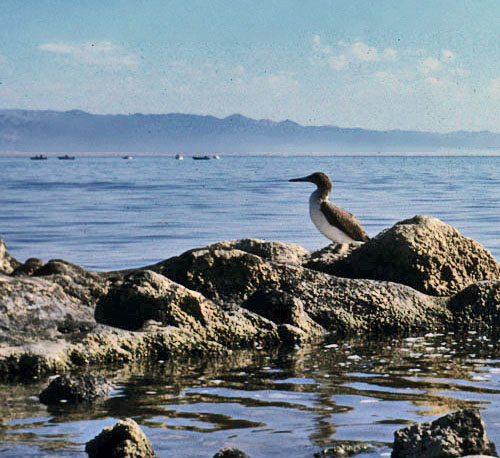
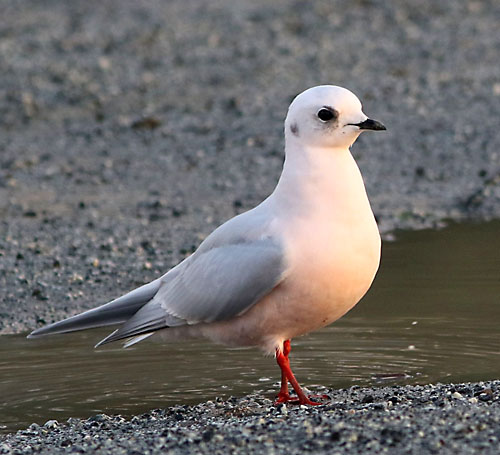
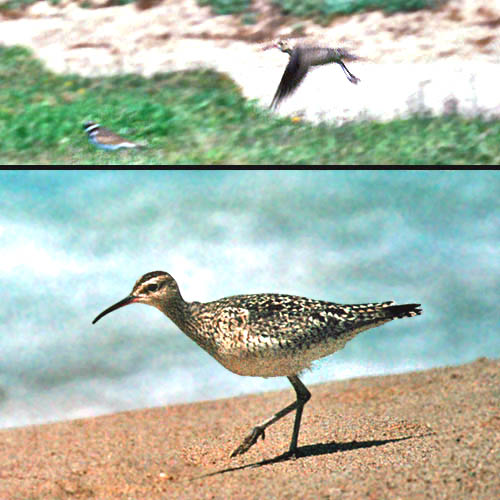
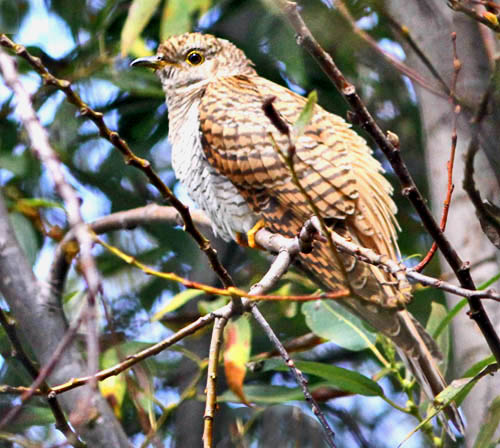
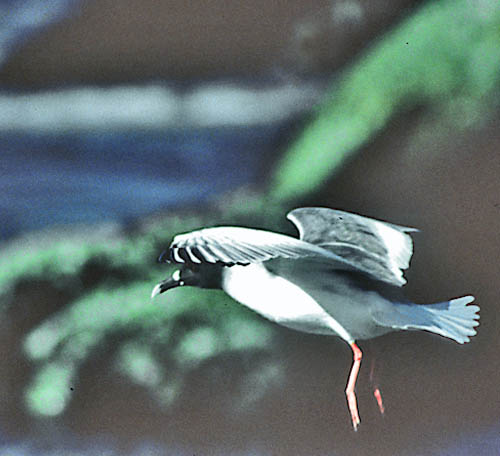
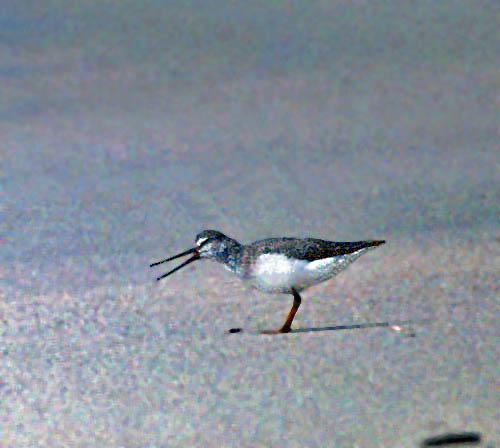
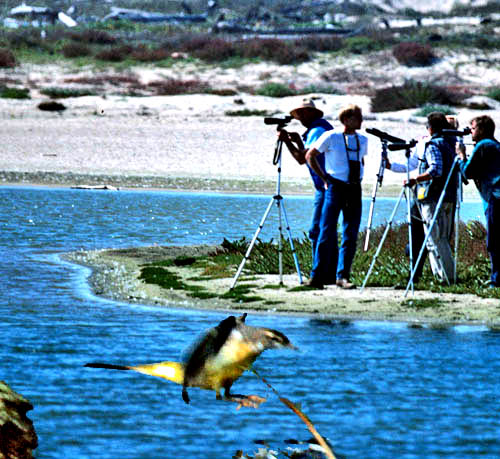

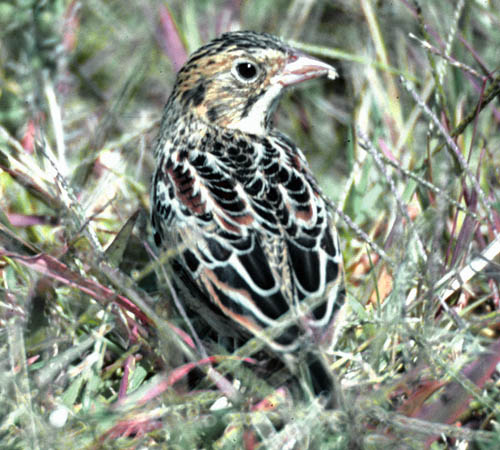
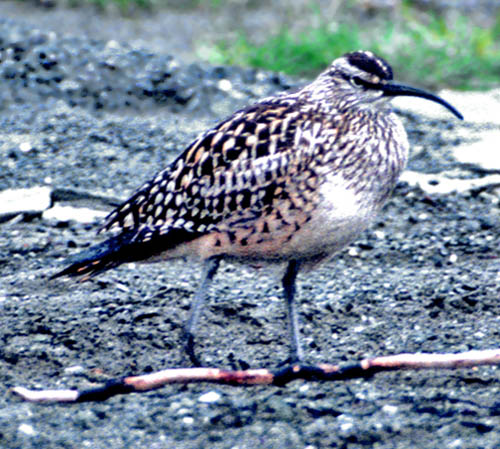
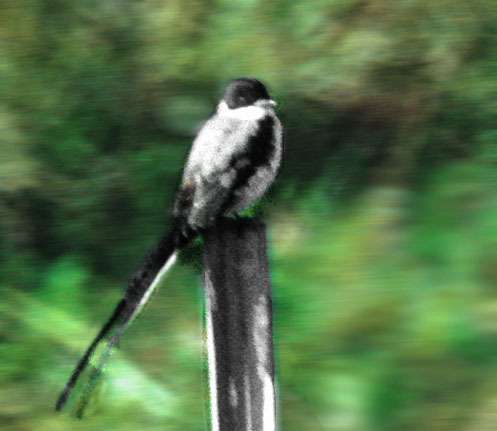
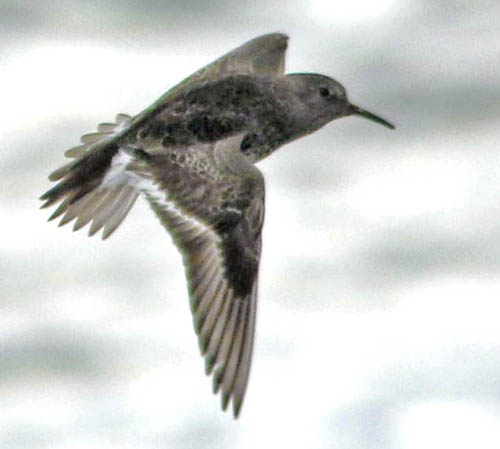
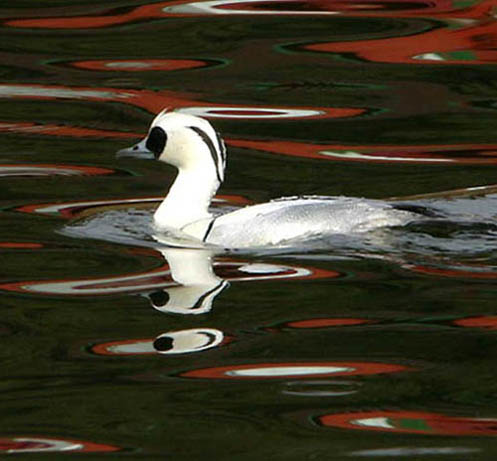
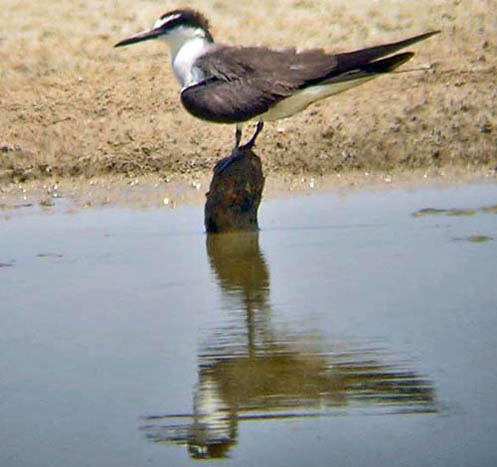
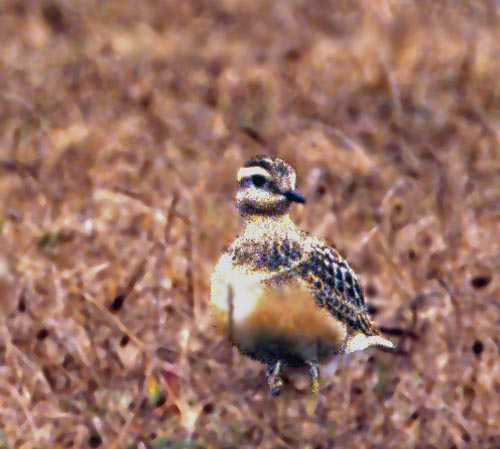
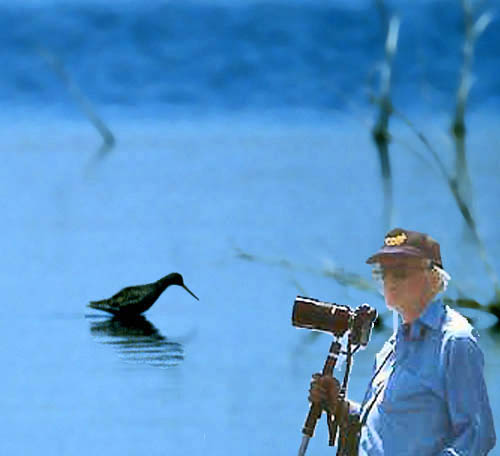

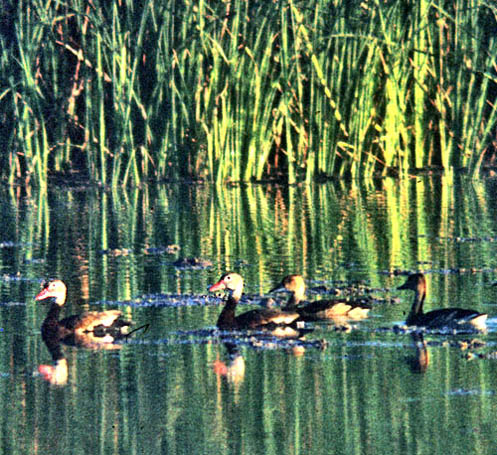
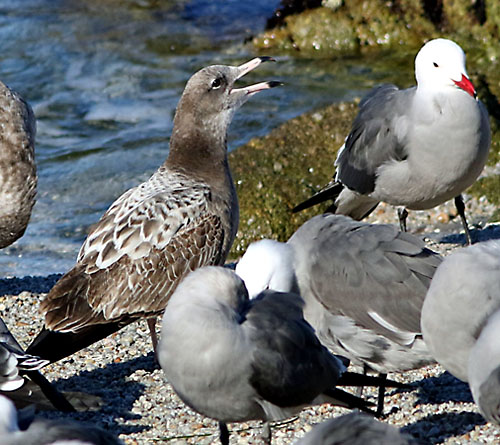
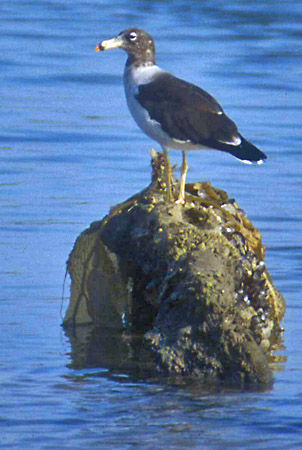 Chasing
rarities — an essential element in the birding subculture — can be
incredibly exhilarating and devastingly depressing. Bill Oddie
explained the entire British birding subculture in his hilarious 1980
book Bill Oddie's Little Black Bird Book. That world was
divided into birders and "dudes" [folks who pretend to be birders but
don't really know birds very well]. A fair number of both "birders" and
"dudes" were within the separate subculture of the "twitchers." Oddie
explained that "whilst to many birders the major thrill is to actually
find a new or rare bird for themselves, the twitcher is more frequently
to be found in pursuit of other people's birds. Whilst birding may be
assumed to be a relatively solitary activity, it is not so for
twitchers. Usually the hunt in packs." Twitchers are obsessed with the
"tick" [seeing the bird you are chasing] and afraid of the "dip"[not
seeing the bird you are chasing]. Bill Oddie continues: "Let's say it's
Friday evening. The grapevine has spread the news of this weekend's
available ticks, so all over the country groups of twitchers plan their
weekend itinerary. The birds are pin-pointed on the map, and away the
twitchers go; the distances traveled are truly phenomenal."
Chasing
rarities — an essential element in the birding subculture — can be
incredibly exhilarating and devastingly depressing. Bill Oddie
explained the entire British birding subculture in his hilarious 1980
book Bill Oddie's Little Black Bird Book. That world was
divided into birders and "dudes" [folks who pretend to be birders but
don't really know birds very well]. A fair number of both "birders" and
"dudes" were within the separate subculture of the "twitchers." Oddie
explained that "whilst to many birders the major thrill is to actually
find a new or rare bird for themselves, the twitcher is more frequently
to be found in pursuit of other people's birds. Whilst birding may be
assumed to be a relatively solitary activity, it is not so for
twitchers. Usually the hunt in packs." Twitchers are obsessed with the
"tick" [seeing the bird you are chasing] and afraid of the "dip"[not
seeing the bird you are chasing]. Bill Oddie continues: "Let's say it's
Friday evening. The grapevine has spread the news of this weekend's
available ticks, so all over the country groups of twitchers plan their
weekend itinerary. The birds are pin-pointed on the map, and away the
twitchers go; the distances traveled are truly phenomenal."
